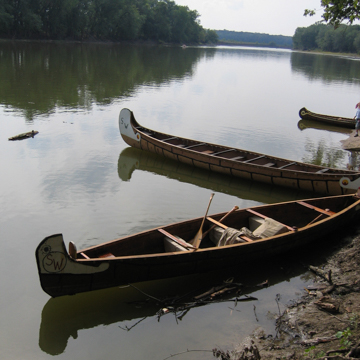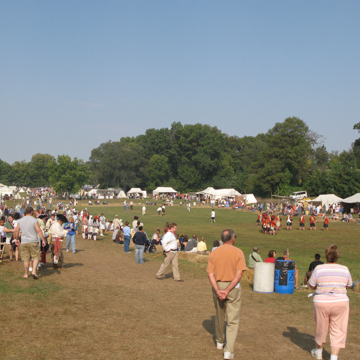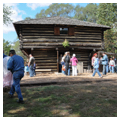You are here
Fort Ouiatenon
In 1717, the government of New France established the first European settlement in what is now Indiana, along the Wabash River just west of the present-day city of Lafayette. The outpost was known as Fort Ouiatenon, a French transliteration of the name for the dwelling place of the local Wea ( Ouia) tribe that had established a large village on the opposite side of the river. The Wabash (called the Ouabache by the French) was a major fur-trade route for voyageurs (literally “travelers”) who came down from Montreal each season with European goods to trade with Native American peoples in exchange for buffalo, beaver, and other animal furs that would be shipped to Europe for sale. The Wabash empties into the Ohio River, providing a route from Indiana to the French city of New Orleans on the Gulf of Mexico. The French provided a small garrison at Ouiatenon, with the goal of deterring British encroachment into the middle of the continent while also providing for strategic alliances with local native groups. The post also provided services requested by the local Native Americans: a military officer to govern the Europeans, a blacksmith, and, later, a priest. By the mid-eighteenth century, Ouiatenon had become one of the most successful trading posts in New France and boasted a European population of several thousand in and around the fort’s palisade. In addition to the Wea, other Native American tribes established settlements around Ouiatenon, including the Kickapoo, Mascouten, Sauk, and Fox. The post served as a vibrant, multicultural center for trade in the Wabash Valley.
Fort Ouiatenon’s first and second commandants, a father and son named Francois Marie Bisot, Sieur de Vincennes, earned the respect of the native peoples of Indiana. The younger Vincennes established additional outposts along the Wabash to the north and south of Ouiatenon. Fort St. Philippe des Miamis (present-day Fort Wayne) was established in 1722 and Post Vincennes (the present-day city of Vincennes) in southern Indiana was founded by Vincennes and a contingent of European and Native American Ouiatenon residents in 1731. The outbreak of the French and Indian War led to unrest in the Wabash Valley. In 1761, the French relinquished control of Ouiatenon to the British. The British proved less hospitable neighbors than the French and had little interest in deterring the encroachment of European settlers into the surrounding country. In 1763, the Ottawa Chief Pontiac captured Ouiatenon without firing a shot. Following a peace treaty in 1765, the fort passed back to the British but was not re-garrisoned.
Many of the Frenchmen at Ouiatenon married Native American women, blending families and cultures. A population of French and Native American residents remained in and around the fort following the British takeover and the American Revolution. In 1791, George Washington ordered Brigadier General Charles Scott of Kentucky to destroy Fort Ouiatenon, its surrounding villages, and all nearby Native American settlements. Many residents escaped, but Scott’s troops took more than forty women and children as prisoners and killed the remaining Native Americans. They then burned the villages, food stores, and hundreds of acres of crops to ensure that the Native Americans could not return.
The site of Ouiatenon was abandoned for roughly three decades before the first settlers from the eastern United States reached the Wabash Valley in the 1820s. These settlers found traces of Ouiatenon, turning up large quantities of artifacts when they tilled the land. One recalled seeing prairie grasses of the Wea Plains ornamented with beads, the grasses having grown up through the eyes of these artifacts. In 1928, local physician and historian Richard B. Wetherill acquired land believed to contain the original site of Fort Ouiatenon. Wetherill built a blockhouse inspired by eighteenth-century British forts on the site in 1930, and the grounds are now maintained as Fort Ouiatenon Historical Park. The 1930 blockhouse remains the primary structure on the site. It is constructed of round logs (telephone poles) laid horizontally, with overlapping corner joints. The first floor contains a single room with a fireplace and an enclosed stair leads to a second-floor room. The second floor cantilevers out around the perimeter of the building and is capped by a hipped roof.
The actual site of Fort Ouiatenon was rediscovered near the park in 1967, when a farmer tilled his field, revealing the charred outline of the fort’s palisade. The site was listed in the National Register of Historic Places in 1970. Archaeological excavation of the fort site took place during the 1970s under the direction of Michigan State University. In 1968, the Tippecanoe County Historical Association established the Feast of the Hunter’s Moon as a historical reenactment festival celebrating the many cultures who called Ouiatenon home. The event, held at the Ouiatenon park, is now one of the largest festivals in Indiana, drawing more than 8,000 participants and more than 60,000 visitors.
References
Cox, Sanford C. Recollections of the Early Settlement of the Wabash Valley. Lafayette, IN: Courier Steam Book and Job Printing House, 1860.
“Feast of the Hunter’s Moon.” Tippecanoe County Historical Association. Accessed October 19, 2014. https://www.tippecanoehistory.org/.
“Fort Ouiatenon.” Tippecanoe County Historical Association. Accessed October 19, 2014. https://www.tippecanoehistory.org/.
Krauskopf, Frances. “Ouiatanon [sic] Documents.” Indiana Historical Society Publications18, no. 2 (1955).
McGroarty, Jean. “The French Period in Indiana.” Tippecanoe Tales. No. 7. Lafayette, IN: Tippecanoe County Historical Association, 1981.
Writing Credits
If SAH Archipedia has been useful to you, please consider supporting it.
SAH Archipedia tells the story of the United States through its buildings, landscapes, and cities. This freely available resource empowers the public with authoritative knowledge that deepens their understanding and appreciation of the built environment. But the Society of Architectural Historians, which created SAH Archipedia with University of Virginia Press, needs your support to maintain the high-caliber research, writing, photography, cartography, editing, design, and programming that make SAH Archipedia a trusted online resource available to all who value the history of place, heritage tourism, and learning.
























